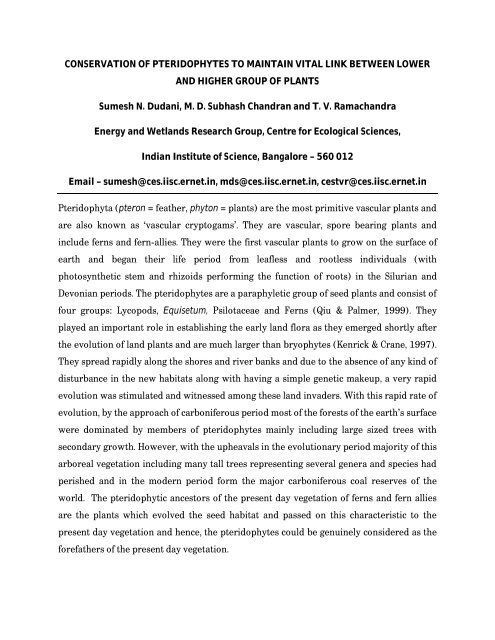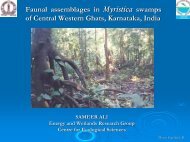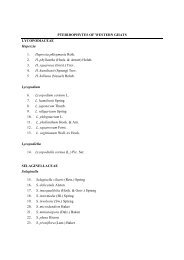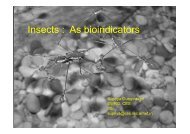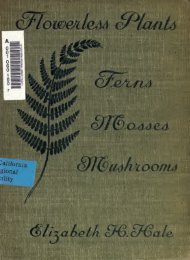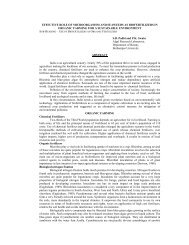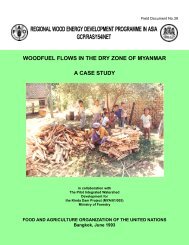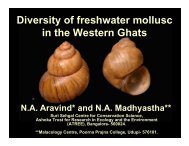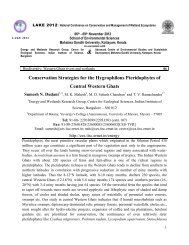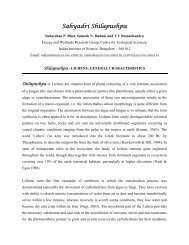conservation of pteridophytes to maintain vital link between
conservation of pteridophytes to maintain vital link between
conservation of pteridophytes to maintain vital link between
You also want an ePaper? Increase the reach of your titles
YUMPU automatically turns print PDFs into web optimized ePapers that Google loves.
CONSERVATION OF PTERIDOPHYTES TO MAINTAIN VITAL LINK BETWEEN LOWER<br />
AND HIGHER GROUP OF PLANTS<br />
Sumesh N. Dudani, M. D. Subhash Chandran and T. V. Ramachandra<br />
Energy and Wetlands Research Group, Centre for Ecological Sciences,<br />
Indian Institute <strong>of</strong> Science, Bangalore – 560 012<br />
Email – sumesh@ces.iisc.ernet.in, mds@ces.iisc.ernet.in, cestvr@ces.iisc.ernet.in<br />
Pteridophyta (pteron = feather, phy<strong>to</strong>n = plants) are the most primitive vascular plants and<br />
are also known as ‘vascular cryp<strong>to</strong>gams’. They are vascular, spore bearing plants and<br />
include ferns and fern-allies. They were the first vascular plants <strong>to</strong> grow on the surface <strong>of</strong><br />
earth and began their life period from leafless and rootless individuals (with<br />
pho<strong>to</strong>synthetic stem and rhizoids performing the function <strong>of</strong> roots) in the Silurian and<br />
Devonian periods. The <strong>pteridophytes</strong> are a paraphyletic group <strong>of</strong> seed plants and consist <strong>of</strong><br />
four groups: Lycopods, Equisetum, Psilotaceae and Ferns (Qiu & Palmer, 1999). They<br />
played an important role in establishing the early land flora as they emerged shortly after<br />
the evolution <strong>of</strong> land plants and are much larger than bryophytes (Kenrick & Crane, 1997).<br />
They spread rapidly along the shores and river banks and due <strong>to</strong> the absence <strong>of</strong> any kind <strong>of</strong><br />
disturbance in the new habitats along with having a simple genetic makeup, a very rapid<br />
evolution was stimulated and witnessed among these land invaders. With this rapid rate <strong>of</strong><br />
evolution, by the approach <strong>of</strong> carboniferous period most <strong>of</strong> the forests <strong>of</strong> the earth’s surface<br />
were dominated by members <strong>of</strong> <strong>pteridophytes</strong> mainly including large sized trees with<br />
secondary growth. However, with the upheavals in the evolutionary period majority <strong>of</strong> this<br />
arboreal vegetation including many tall trees representing several genera and species had<br />
perished and in the modern period form the major carboniferous coal reserves <strong>of</strong> the<br />
world. The pteridophytic ances<strong>to</strong>rs <strong>of</strong> the present day vegetation <strong>of</strong> ferns and fern allies<br />
are the plants which evolved the seed habitat and passed on this characteristic <strong>to</strong> the<br />
present day vegetation and hence, the <strong>pteridophytes</strong> could be genuinely considered as the<br />
forefathers <strong>of</strong> the present day vegetation.
The word ‘cryp<strong>to</strong>gams’ is formed from two Greek words namely ‘krup<strong>to</strong>s’ meaning hidden<br />
and ‘gamos’ meaning wedded. The cryp<strong>to</strong>gams form the lower group <strong>of</strong> plants including all<br />
those plants which reproduce by the means <strong>of</strong> spores and do not produce seeds including<br />
algae, fungi, bryophytes and <strong>pteridophytes</strong>. The term sperma<strong>to</strong>phyte is also derived from<br />
Greek words ‘sperma<strong>to</strong>s’ meaning seed and ‘phy<strong>to</strong>n’ meaning plant and it refers <strong>to</strong> the<br />
higher group <strong>of</strong> seed producing plants including Gymnosperms and Angiosperms. The<br />
lower cryp<strong>to</strong>gams, i.e. algae, fungi and bryophytes do not possess a well developed<br />
conducting system whereas the sperma<strong>to</strong>phytes or phanerogams possess a well developed<br />
and differentiated vascular system for conduction <strong>of</strong> water and nutrients in the plant body.<br />
The <strong>pteridophytes</strong> were the first group <strong>of</strong> cryp<strong>to</strong>gams <strong>to</strong> be showing the presence <strong>of</strong> a well<br />
developed conducting system with xylem (mainly composed <strong>of</strong> tracheids) and phloem.<br />
Hence, they are regarded as ‘Vascular cryp<strong>to</strong>gams’ which can be referred <strong>to</strong> an assemblage<br />
<strong>of</strong> seedless vascular plants which have successfully invaded the land and reproduce by the<br />
means <strong>of</strong> spores. As they show the evolution <strong>of</strong> vascular system and reflect the emergence<br />
<strong>of</strong> seed habitat in the plant, they are considered <strong>to</strong> be a <strong>vital</strong> <strong>link</strong> <strong>between</strong> the lower<br />
cryp<strong>to</strong>gam group <strong>of</strong> plants and higher sperma<strong>to</strong>phyte group <strong>of</strong> plants. Hence are placed<br />
<strong>between</strong> bryophytes and higher vascular plants i.e., gymnosperms and angiosperms in the<br />
hierarchical plant classification system. They are connected <strong>to</strong> the bryophytes as they show<br />
the ‘Heteromorphic life cycle’ with alternation <strong>of</strong> generations and they are also connected<br />
with the gymnosperms and angiosperms by showing the presence <strong>of</strong> vascular system for<br />
conduction.<br />
Pteridophytes grow luxuriantly in moist tropical forests and temperate forests and their<br />
occurrence in different eco-geographically threatened regions from sea level <strong>to</strong> the highest<br />
mountains are <strong>of</strong> much interest (Dixit, 2000). Though they have been largely replaced by<br />
the sperma<strong>to</strong>phytes in the modern day flora, they continue <strong>to</strong> occupy an important and<br />
crucial position in the evolutionary his<strong>to</strong>ry <strong>of</strong> the plant kingdom. India has a rich and varied<br />
pteridophytic flora due <strong>to</strong> its diversified <strong>to</strong>pography, variable climatic conditions and its<br />
geographical position with several migration-flows <strong>of</strong> species <strong>of</strong> different<br />
phy<strong>to</strong>geographical elements meeting in different parts <strong>of</strong> the Country. They occur in a
variety <strong>of</strong> habitats like terrestrial (Equisetum, Selaginella), aquatic (Azolla, Marsilea),<br />
epiphytic (Lepisorus, Drynaria) and lithophytic (Psilotum, Adiantum).<br />
General account and Life-Cycle <strong>of</strong> Pteridophytes<br />
Pteridophytes form a major part <strong>of</strong> the flora next <strong>to</strong> the angiosperms in the species<br />
diversity rich region like India. Their life cycle shows alteration <strong>of</strong> generations with<br />
sporophyte being the dominant phase. The sporophyte <strong>of</strong> <strong>pteridophytes</strong> is generally<br />
differentiated in<strong>to</strong> root, stem and leaves. The primary root is short lived and is usually<br />
replaced by adventitious roots. The stem is usually branched and the branches do not arise<br />
in the axil <strong>of</strong> the leaves. The leafy branch <strong>of</strong> the fern is called a ‘frond’ and the small leaflets<br />
that make up the whole frond are termed as ‘pinnae’. The leaves may be simple<br />
(Equisetum), simple and sessile (Selaginella, Lycopodium) or large and pinnately compound<br />
(Dryopteris, Adiantum). The vascular system consists <strong>of</strong> xylem (composed <strong>of</strong> tracheids, true<br />
fibres and vessels absent) and phloem (consisting <strong>of</strong> only sieve tubes). They have an<br />
affinity for the sheltered places under the forest canopy along creeks and streams and<br />
other sources <strong>of</strong> permanent moisture.<br />
The life cycle <strong>of</strong> the fern differs from both higher plants (Gymnosperm, Angiosperm) and<br />
Bryophytes. In bryophytes the game<strong>to</strong>phytic generation is the dominant phase in the life<br />
cycle and the sporophyte phase is dependent upon it whereas in angiosperms, the<br />
sporophyte is the dominant phase and the game<strong>to</strong>phyte is dependent upon it. However, in<br />
<strong>pteridophytes</strong>, both the sporophytic phase and game<strong>to</strong>phytic phase in the life cycle are<br />
independent <strong>of</strong> each other. The reproduction in <strong>pteridophytes</strong> takes place with the help <strong>of</strong><br />
spores. Some <strong>pteridophytes</strong> give rise <strong>to</strong> two different types <strong>of</strong> spores – large, female spores<br />
called as megaspores and small, male spores called as microspores. Such <strong>pteridophytes</strong> are<br />
referred <strong>to</strong> as ‘Heterosporous’ <strong>pteridophytes</strong>. The living species <strong>of</strong> Heterosporous<br />
<strong>pteridophytes</strong> are small herbaceous perennials usually not more than a few inches high<br />
and fall in<strong>to</strong> six genera namely Azolla, Salvinia, Marsilea, Pilularia, Isoetes, and Selaginella<br />
(Schaffner, 1905). Those <strong>pteridophytes</strong> which possess only one kind <strong>of</strong> non-sexual<br />
reproductive spores are referred <strong>to</strong> as ‘Homosporous’ <strong>pteridophytes</strong>. These <strong>pteridophytes</strong>
possess true fibro-vascular system, true roots and leaves and fall naturally in<strong>to</strong> three<br />
distinct classes – Ferns or Filices, Horsetails or Equisetaceae and Lycopods or<br />
Lycopodiaceae (Schaffner, 1906).<br />
The sporophyte <strong>of</strong> the pteridophyte produces spores inside the sporangia after meiosis.<br />
The sporangia develop either on the ventral surface <strong>of</strong> leaves (as in case <strong>of</strong> ferns) or in the<br />
axil <strong>of</strong> stem and leaves (Lycopodium, Selaginella). The sporangia bearing leaves are called<br />
as ‘sporophylls’. The development <strong>of</strong> the <strong>pteridophytes</strong> is <strong>of</strong> two different types:<br />
1. Eusporangiate development – wherein the sporangium develops from a group <strong>of</strong><br />
superficial cells. Examples – Lycopodium, Selaginella, Equisetum<br />
2. Lep<strong>to</strong>sporangiate development – wherein the sporangium develops from a single<br />
initial cell. Examples – Pteris, Polypodium<br />
The spores germinate <strong>to</strong> give rise <strong>to</strong> the game<strong>to</strong>phyte known as prothallus which is green<br />
and bears sex organs – antheridia and archegonia. The homosporous <strong>pteridophytes</strong> form<br />
monoecious prothallus whereas the heterosporous <strong>pteridophytes</strong> form the dioecious<br />
prothallus. The antheridium gives rise <strong>to</strong> numerous antherozoids which are ciliated. Water<br />
is essential for the fertilization process as the antherozoids travel <strong>to</strong> the archegonia in the<br />
presence <strong>of</strong> water. The fertilization <strong>between</strong> the male and female gametes results in the<br />
formation <strong>of</strong> zygote which gives rise <strong>to</strong> the sporophyte.
Fig.1 – Life cycle <strong>of</strong> a Homosporous Pteridophyte (eg: Equisetum)<br />
Contributed by: Pr<strong>of</strong>. Nilesh Mulia, Department <strong>of</strong> Botany, M.G. Science Institute, Ahmedabad
Fig.2 – Life cycle <strong>of</strong> a Heterosporous Pteridophyte (eg: Marsilea)<br />
Contributed by: Pr<strong>of</strong>. Nilesh Mulia, Department <strong>of</strong> Botany, M.G. Science Institute, Ahmedabad<br />
Different habits and habitats <strong>of</strong> ferns<br />
Due <strong>to</strong> availability <strong>of</strong> favourable climatic conditions and suitable habitats for growth, the<br />
<strong>pteridophytes</strong> are widely distributed in Indian continent, even becoming abundant and<br />
conspicuous at some parts. However, they need proper microclimatic conditions for their<br />
survival and any disturbance in these conditions may lead <strong>to</strong> their extinction. Each fern
species has its own preferences for temperature, humidity, soil type, moisture, etc. and in<br />
many cases are very specific indica<strong>to</strong>rs for the conditions they need (Shaikh & Dongare,<br />
2009). Though some studies have been done taking different habits and habitats <strong>of</strong><br />
<strong>pteridophytes</strong> in<strong>to</strong> account, in-depth ecological studies have not been done on the Indian<br />
<strong>pteridophytes</strong>. The <strong>pteridophytes</strong> grow in different habitats like moist or dry rocks and<br />
boulders, on tree trunks, as hydrophytes in lakes, ponds, etc., on forest floors and edges,<br />
along perennial streams and deep ravines, grasslands, tea and c<strong>of</strong>fee estates, inside dark<br />
Georges, etc. Ecologically various members <strong>of</strong> ferns and fern allies inhabiting a region can<br />
be classified in<strong>to</strong> different categories depending upon their growth habits and various<br />
habitats they occupy.<br />
Some <strong>pteridophytes</strong> grow as epiphytes on the stem and branches <strong>of</strong> the trees in moist and<br />
shady evergreen forests. The barks or branches covered with moss and humus form ideal<br />
base for their growth. Some <strong>of</strong> the epiphytic pteridophyte species are Drynaria quercifolia,<br />
Lepisorus nudus, Microsorum punctatum, Asplenium nidus, Huperzia squarrosum, etc. Most <strong>of</strong><br />
these epiphytic species prefer trees like Ficus sp. and Mangifera sp. At high altitudes, the<br />
stems and branches <strong>of</strong> trees are usually covered with moist mossy surface and leafy<br />
liverworts which provide an ideal condition for the growth <strong>of</strong> <strong>pteridophytes</strong>. The ferns and<br />
fern allies like Hymenophyllum javanicum, Araiostegia pulchra, Vittaria elongata,<br />
Didymoglossum insignis, Ctenopteris subfulcata, etc. occur at such places.<br />
Majority <strong>of</strong> ferns and fern allies are terrestrial growing and differing in growth and habitat<br />
they occupy. Some major terrestrial growing pteridophyte genera are Pteris, Dryopteris,<br />
Athyrium, Diplazium, Thelypteris, Cyclosorus, Alsophila, etc. Some terrestrial ferns like<br />
Dicranopteris linearis grow abundantly and form thickets in the forests. Species like Pteris<br />
vittata, Diplazium esculentum, Pronephrium nudatum, Lep<strong>to</strong>chillus axillaries grow in moist<br />
and shady places whereas species like Asplenium bulbatum, Diplazium esculentum, Pteris<br />
semipinnata, etc. grow in the edge <strong>of</strong> forests along secondary forests (Dixit, 2000).<br />
The fern genera Lygodium, Stenochlaena and Microsorium are climbing ferns with<br />
underground serpentine rhizomes. For securing favourbale light conditions, the plants
grow up the adjacent shrubs and branches <strong>of</strong> nearby trees with the help <strong>of</strong> rachis.<br />
Microsorium superfeciable occurs in the dense evergreen forest while Lygodium japonicum,<br />
L. flexuosum and L. circinalis normally occur up<strong>to</strong> 1000m altitude (Dixit, 2000).<br />
Some ferns are lithophytes and are found in rock crevices and among rock boulders along<br />
water channels. Species such as Adiantum venustum, A. capillusveneris and Asplenium<br />
rutamaria grow in wall crevices under shade or around falls among rock boulders (Dixit,<br />
2000). Other examples <strong>of</strong> lithophytic species are Cheilanthes farinose, Pityrogramma<br />
calomelanos, Adiantum philipense, etc.<br />
Economic importance <strong>of</strong> <strong>pteridophytes</strong><br />
Man has been dependent upon the plants as an important source <strong>of</strong> medicine since ancient<br />
times. Even <strong>to</strong>day, many tribal communities and rural population is dependent heavily<br />
upon the natural resources obtained from the surrounding forest regions for treatment <strong>of</strong><br />
various ailments and diseases. The Indian traditional medicine is based on different<br />
systems such as Ayurveda, Siddha and Unani used by various tribal communities (Gadgil,<br />
1996).Though, lot <strong>of</strong> studies focusing on the medicinal properties <strong>of</strong> plants, especially<br />
angiosperms, have been taken place, unfortunately limited amount <strong>of</strong> studies have been<br />
done <strong>to</strong> explore the medicinal potentialities <strong>of</strong> the <strong>pteridophytes</strong>. The <strong>pteridophytes</strong><br />
constitute a significant part <strong>of</strong> the earth’s plant diversity and being the second largest<br />
group <strong>of</strong> vascular plants, they form a dominant component <strong>of</strong> many plant communities. The<br />
medicinal qualities <strong>of</strong> ferns, real or imaginary, are mentioned as early as 300 B.C. by the<br />
Greek philosopher Theophrastus and by his Indian contemporaries Sushrut and Charak.<br />
The medicinal uses <strong>of</strong> some ferns and <strong>pteridophytes</strong> <strong>of</strong> India have also been described<br />
(Caius, 1935; Nair, 1959). The medicinal uses <strong>of</strong> 61 different ferns and fern-allies have been<br />
well described by (Benjamin & Manickam, 2007). Adiantum capillus-veneris and Marsilea<br />
minuta have been mentioned as <strong>of</strong> medicinal importance in ‘Charak Samhita’ and the<br />
rhizome <strong>of</strong> Polystichum squamosum, which is known as ‘Nirviri’ in India is effectively used<br />
against scorpion bite and insect bites (Dixit, 2000). The leaf and root decoction <strong>of</strong><br />
commonly occurring Adiantum lunulatum has been found <strong>to</strong> be very effective in the<br />
treatment <strong>of</strong> chest complaints (Nair, 1959; Rout et al, 2009). The leaf extract <strong>of</strong> Angiopteris
evecta is used in treatment <strong>of</strong> dysentery whereas the spores are effective in the treatment<br />
<strong>of</strong> leprosy and other skin diseases (Kirtkar et al, 1935). Actiniopteris radiata possesses the<br />
properties like anthelmintic, astringent, sweet, cooling, acrid, febrifuge and is used for<br />
treating severe conditions <strong>of</strong> diarrhea, dysentery, helminthiasis, haemopstysis and fever<br />
(Warrier et al, 1996).<br />
Another important pteridophyte which plays many important and different roles in the<br />
ecosystem is Azolla (Family – Azollaceae). It is a genus <strong>of</strong> small, aquatic, heterosporous,<br />
lep<strong>to</strong>sporangiate ferns, commonly found in still or slow moving water ponds, ditches,<br />
swamps, lakes, tanks. One important characteristics <strong>of</strong> Azolla is its symbiotic association<br />
with nitrogen-fixing, blue-green algae namely – Anabaena azollae Strasburger. Due <strong>to</strong> this<br />
property, the agronomic potential <strong>of</strong> Azolla as bi<strong>of</strong>ertilizer for rice has been recognized in<br />
many countries including India, Philippines, USA, Sri Lanka and Thailand (Ahluwalia et al,<br />
2002). It has been also found that by applying Azolla the soil fertility is improved by<br />
increasing <strong>to</strong>tal nitrogen, available organic carbon, phosphorous and potassium (Mandal et<br />
al, 1999; Sharma et al, 1999). Azolla has also been used as food supplement in fresh or<br />
dried or silage form for aa variety <strong>of</strong> animals including pigs, cattle, rabbits, ducks, chicken<br />
and fish (Ahluwalia et al, 2002). Azolla can also be used for control <strong>of</strong> weeds like Eichornia<br />
sp., Chara sp., Nitella sp. and Hygrophila sp. (Sahoo & Datta, 1999). The remarkable activity<br />
<strong>of</strong> Azolla <strong>to</strong> take up heavy metals from polluted water can be used for treatment <strong>of</strong><br />
wastewater (Sanyahumbi et al, 1998; Vermaat & Hanif, 1998). Its use as traditional<br />
medicine for treating cough and sore throat is also known (Wagner, 1997; Usher, 1974).<br />
Other uses <strong>of</strong> Azolla include hydrogen production, biogas production, as an ingredient in<br />
soap production and <strong>to</strong> certain extent as human food (Ahluwalia et al, 2002).<br />
The ferns have also shown <strong>to</strong> be having an important role in bioremediation <strong>of</strong> wastewater.<br />
Ma et al. (2001) found the Chinese Bracken fern namely Pteris vittata L. <strong>to</strong> be a<br />
hyperaccumula<strong>to</strong>r <strong>of</strong> the <strong>to</strong>xic metal Arsenic. Besides producing large biomass, they also<br />
found this fern <strong>to</strong> be efficient in Ar accumulation with the concentrations as high as 2.3% in<br />
the aerial portions <strong>of</strong> the fern. Later on, many researchers provided the reports <strong>of</strong> the<br />
hyperaccumulation properties <strong>of</strong> Pteris as well as many other ferns also. Tu et al. (2002)
suggested that P. vittata could be an excellent model <strong>to</strong> study arsenic uptake, translocation,<br />
speciation, distribution and de<strong>to</strong>xification in plants and for phy<strong>to</strong>remediation <strong>of</strong> arsenic<br />
contaminated soil and water. Researchers like Nichols et al., 2000; Olguín et al. 2002; Sun˜e<br />
et al., 2007) have shown that several species <strong>of</strong> Salvinia such as S. herzogii, S. minima, S.<br />
natans, S. rotundifolia possess the potential <strong>of</strong> removing various contaminants including<br />
heavy metals from the wastewater. The non-living biomass <strong>of</strong> Salvinia exhibit equivalently<br />
high potential <strong>to</strong> remove heavy metals (Dhir, 2009). The advantageous features <strong>of</strong> Salvinia<br />
such as wide geographical distribution, high productivity, high surface area and carboxylic<br />
content, efficiency <strong>of</strong> pollutant removal throughout different seasons, higher rate <strong>of</strong> metal<br />
removal per surface unit and easy <strong>to</strong> grow makes it an important species <strong>to</strong> be used in<br />
phy<strong>to</strong>remediation technologies (Dhir, 2009).<br />
Besides having all these wonderful properties, the <strong>pteridophytes</strong> are also greatly valued as<br />
ornamentals. Prior <strong>to</strong> the discovery <strong>of</strong> these benefits obtained from this group <strong>of</strong> plants,<br />
ferns were used <strong>to</strong> enhance the beauty <strong>of</strong> the landscape and are continued <strong>to</strong> be used so till<br />
now. Nephrolepis cordifolia also commonly known as ‘Sword fern’ is one <strong>of</strong> the most<br />
commonly used ornamental fern species. Other ferns like Adiantum capillus-veneris,<br />
Asplenium sp., Selaginella sp., Lygodium sp., Pteris sp., etc. are also grown in the gardens or<br />
in the pots. Many nurseries grow these ferns and sell them <strong>of</strong>f for a good price and these<br />
ferns are then used as ornamentals either as garden plants or during functions <strong>to</strong> beautify<br />
the place.<br />
Threats and <strong>conservation</strong> <strong>of</strong> <strong>pteridophytes</strong><br />
The <strong>pteridophytes</strong> are moisture and shade loving plants and dependent upon the<br />
microclimatic conditions <strong>of</strong> the region for their successful survival in that region. Any kind<br />
<strong>of</strong> disturbance in these microclimatic conditions can hinder the growth and evolutionary<br />
processes occurring naturally in these plants thereby, leading <strong>to</strong> decline in their<br />
populations. Thus, fac<strong>to</strong>rs like climate change, increasing urbanization, industrialization,<br />
encroachment <strong>of</strong> forest lands, unplanned developmental activities, over exploitation <strong>of</strong><br />
natural resources, pose a major threat <strong>to</strong> the survival <strong>of</strong> these groups <strong>of</strong> plants. Due <strong>to</strong><br />
unplanned felling <strong>of</strong> trees in the forests the members <strong>of</strong> epiphytic <strong>pteridophytes</strong> belonging
<strong>to</strong> the families Polypodiaceae, Davalliaceae, Aspleniaceae, Vittariaceae, have been reduced<br />
day-by-day (Dixit, 2000). Large scale collection <strong>of</strong> ferns from the forests by the visi<strong>to</strong>rs and<br />
local people for ornamental purpose, medicinal purpose and during excursions also<br />
increases the pressure on these plants.<br />
Biodiversity <strong>conservation</strong> is the need <strong>of</strong> time and hence, it has become imperative <strong>to</strong><br />
develop in situ and ex situ <strong>conservation</strong> methods for <strong>conservation</strong> <strong>of</strong> the diminishing<br />
biodiversity. The in situ <strong>conservation</strong> is very beneficial as it allows the evolution <strong>of</strong> the<br />
species <strong>to</strong> continue within the area <strong>of</strong> natural occurrence. Hence, the steps for conserving<br />
the ferns in situ should be focused upon. The ex situ <strong>conservation</strong> includes development <strong>of</strong><br />
botanical gardens or conserva<strong>to</strong>ries, germplasm banks, DNA banks, seed banks and involve<br />
the use <strong>of</strong> techniques such as tissue culture, cryopreservation; incorporation <strong>of</strong> disease,<br />
pest and stress <strong>to</strong>lerance traits through genetic transformation and ecological res<strong>to</strong>ration<br />
<strong>of</strong> rare plant species and their populations (Kapai et al, 2010). The <strong>conservation</strong> <strong>of</strong><br />
flowering plants has been achieved <strong>to</strong> good extent by developing conserva<strong>to</strong>ries and<br />
botanical gardens which also help in creating awareness among the local people. However,<br />
developing a fern conserva<strong>to</strong>ry or fern garden is not preferred much and hence, such steps<br />
should be considered and implemented for conserving the rare and endangered species.<br />
The tissue culture is a very useful technique for the mass multiplication <strong>of</strong> the plant species<br />
in a short time and hence, researches focusing on developing a pro<strong>to</strong>col for in vitro<br />
regeneration <strong>of</strong> ferns and fern-allies should be encouraged. Parts <strong>of</strong> areas rich in abundant<br />
pteridophyte diversity can be declared as pteridophyte biosphere reserves or small gene<br />
sanctuaries can be established <strong>to</strong> save the epiphytic <strong>pteridophytes</strong>.


